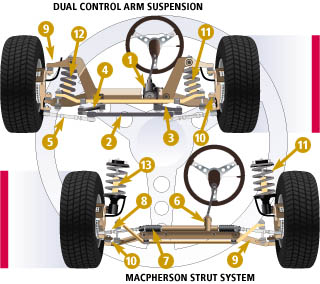Most car owners and drivers do not know a lot about their car’s steering and suspension system. Suspension, when discussing cars, refers to the use of front and rear springs to suspend a vehicle’s “sprung” weight. The springs used on today’s cars and trucks are constructed in a variety of types, shapes, sizes, rates, and capacities. Types include leaf springs, coil springs, air springs, and torsion bars. These are used in sets of four for each vehicle, or they may be paired off in various combinations and are attached by several different mounting techniques.
1. Steering Gear Box
2. Center Link
3. Pitman Arm
4. Idler Arm
5. Tie Rods
6. Rack and Pinion Assembly
7. Bellows Boots
8. Tie Rods
9. Control Arms
10. Ball Joints
11. Springs
12. Shock Absorbers
13. Struts
SUSPENSION SYSTEM – CAR BASIC KNOWLEDGE FOR US TO KNOW
The suspension system also includes shocks and/or struts, and sway bars. Back in the earliest days of automobile development, when most of the car’s weight (including the engine) was on the rear axle, steering was a simple matter of turning a tiller that pivoted the entire front axle. When the engine was moved to the front of the car, complex steering systems had to evolve. The modern automobile has come a long way since the days when “being self-propelled” been enough to satisfy the car owner. Improvements in suspension and steering, increased strength and durability of components, and advances in tire design and construction have made large contributions to riding comfort and to safe driving.

The suspension system has two basic functions, to keep the car’s wheels in firm contact with the road and to provide acomfortable ride for the passengers. A lot of the system’s work is done by the springs. Under normal conditions, the springssupport the body of the car evenly by compressing and rebounding with every up-and-down movement. This up-and-down movement, however, causes bouncing andswaying after each bump and is very uncomfortable to the passenger. These undesirable effects are reduced by theshock absorbers.
Suspension is the term given to the system ofsprings, shock absorbers and linkagesthat connects a vehicle to its wheels. Suspension systems serve a dual purpose – contributing to the car’s handling and braking for good active safety and driving pleasure, and keeping vehicle occupants comfortable and reasonably well isolated from road noise, bumps, and vibrations. These goals are generally at odds, so the tuning of suspensions involves finding the right compromise. The suspension also protects the vehicle itself and any cargo or luggage from damage and wear. The design of front and rear suspension of a car may be different.
Damping is the control of motion or oscillation, as seen with the use of hydraulic gates and valves in a vehicles shock absorber. This may also vary, intentionally or unintentionally. Like spring rate, the optimal damping for comfort may be less than for control.
Damping controls the travel speed and resistance of the vehicles suspension. An undamped car will oscillate up and down. With proper damping levels, the car will settle back to a normal state in a minimal amount of time. Most damping in modern vehicles can be controlled by increasing or decreasing the resistance to fluid flow in the shock absorber.
Camber changes with wheel travel and with body roll. A tire wears and brakes best at -1 to -2 degrees of camber from vertical. Depending on the tire, it may hold the road best at a slightly different angle. Small changes in camber, front and rear, are used to tune handling.
Roll center height is important to body roll and to front to rear roll moment distribution. However, the roll moment distribution in most cars is set more by the antiroll bars. It may affect the tendency to roll over.
Most suspensions use springs to absorb impacts and dampers (or shock absorbers) to control spring motions. Some notable exceptions are the hydropneumatic systems, which can be treated as an integrated unit of gas spring and damping components, used by the French manufacturerCitroën and the hydrolastic, hydragas and rubber cone systems used by the British Motor Corporation, most notably on the Mini.
Kereta Malaysia car info:
- suspension system
- car suspension
- suspension
- car suspension system
- suspension systems
- suspension system of a car
- vehicle suspension system
- suspension car
- suspension system in cars
- car steering system
































